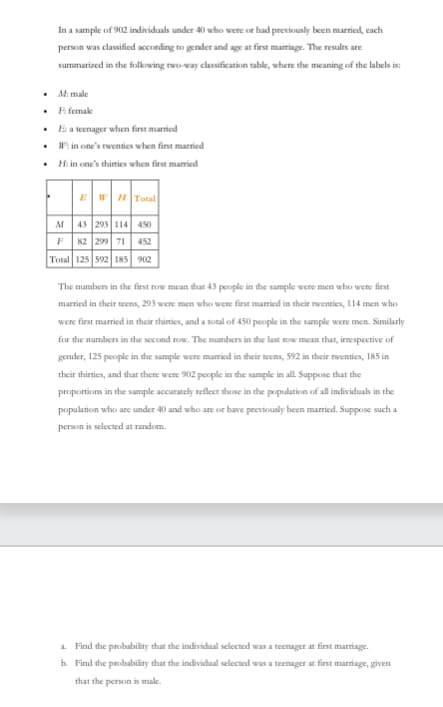In a sample of 902 individuals under 40 who were or had previously been married, each person was classified according to gender and age at first marriage. The results are summarized in the following two-way classification table, where the meaning of the labels is: . M: male • F: female .: a teenager when first married I': in one's twenties when first married • H: in one's thirties when first married EWH Total M 43 293 114 450 F82 299 71 452 Total 125 592 185 902 The numbers in the first row mean that 43 people in the sample were men who were first married in their teens, 293 were men who were first married in their twenties, 114 men who were first married in their thimics, and a total of 450 people in the sample were men. Similarly for the numbers in the second row. The numbers in the last row mean that, irrespective of gender, 125 people in the sample were married in their teens, 592 in their twenties, 185 in their thirties, and that there were 902 people in the sample in all. Suppose that the proportions in the sample accurately reflect those in the population of all individuals in the population who are under 40 and who are or have previously been married. Suppose such a person is selected at random. Find the probability that the individual selected was a teenager at first marriage. & Find the probability that the individual selected was a teenager at first marriage, given that the person is male.
In a sample of 902 individuals under 40 who were or had previously been married, each person was classified according to gender and age at first marriage. The results are summarized in the following two-way classification table, where the meaning of the labels is: . M: male • F: female .: a teenager when first married I': in one's twenties when first married • H: in one's thirties when first married EWH Total M 43 293 114 450 F82 299 71 452 Total 125 592 185 902 The numbers in the first row mean that 43 people in the sample were men who were first married in their teens, 293 were men who were first married in their twenties, 114 men who were first married in their thimics, and a total of 450 people in the sample were men. Similarly for the numbers in the second row. The numbers in the last row mean that, irrespective of gender, 125 people in the sample were married in their teens, 592 in their twenties, 185 in their thirties, and that there were 902 people in the sample in all. Suppose that the proportions in the sample accurately reflect those in the population of all individuals in the population who are under 40 and who are or have previously been married. Suppose such a person is selected at random. Find the probability that the individual selected was a teenager at first marriage. & Find the probability that the individual selected was a teenager at first marriage, given that the person is male.
A First Course in Probability (10th Edition)
10th Edition
ISBN:9780134753119
Author:Sheldon Ross
Publisher:Sheldon Ross
Chapter1: Combinatorial Analysis
Section: Chapter Questions
Problem 1.1P: a. How many different 7-place license plates are possible if the first 2 places are for letters and...
Related questions
Question

Transcribed Image Text:.
.
.
.
In a sample of 902 individuals under 40 who were or had previously been married, each
person was classified according to gender and age at first marriage. The results are
summarized in the following two-way classification table, where the meaning of the labels is:
M: male
F: female
E: a teenager when first married
I': in one's twenties when first married
H: in one's thirties when first married
EWH Total
M 43 293 114 450
F82 299 71 452
Total 125 592 185 902
The numbers in the first row mean that 43 people in the sample were men who were first
married in their teens, 293 were men who were first married in their twenties, 114 men who
were first married in their thirties, and a total of 450 people in the sample were men. Similarly
for the numbers in the second row. The numbers in the last row mean that, irrespective of
gender, 125 people in the sample were married in their teens, 592 in their twenties, 185 in
their thirties, and that there were 902 people in the sample in all. Suppose that the
proportions in the sample accurately reflect those in the population of all individuals in the
population who are under 40 and who are or have previously been married. Suppose such a
person is selected at random.
a. Find the probability that the individual selected was a teenager at first marriage.
b. Find the probability that the individual selected was a teenager at first marriage, given
that the person is male.
Expert Solution
This question has been solved!
Explore an expertly crafted, step-by-step solution for a thorough understanding of key concepts.
Step by step
Solved in 3 steps

Recommended textbooks for you

A First Course in Probability (10th Edition)
Probability
ISBN:
9780134753119
Author:
Sheldon Ross
Publisher:
PEARSON


A First Course in Probability (10th Edition)
Probability
ISBN:
9780134753119
Author:
Sheldon Ross
Publisher:
PEARSON
